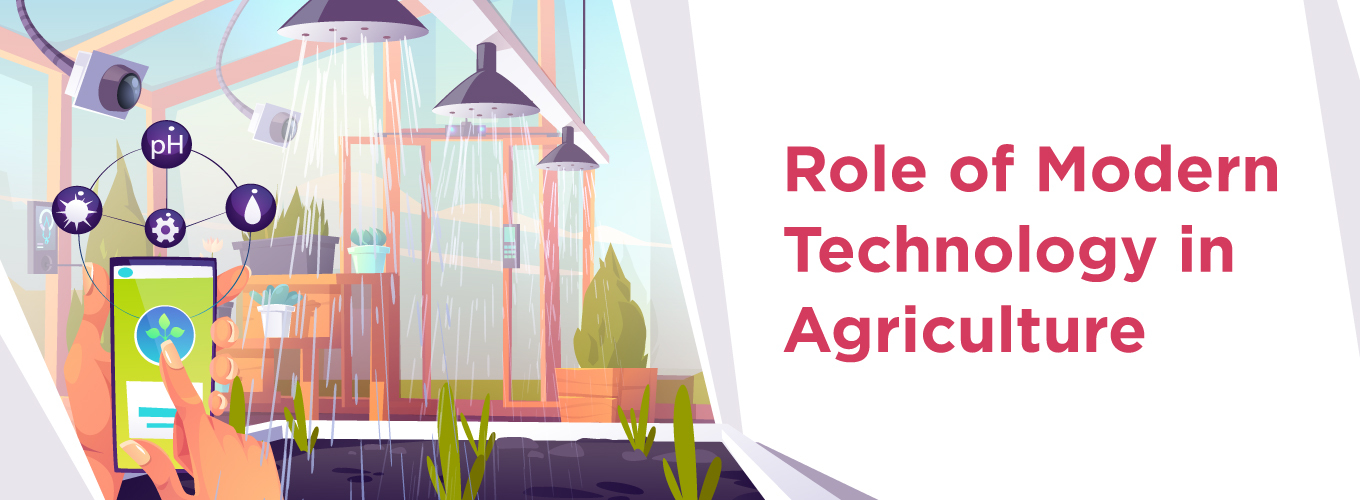Role of Modern Technology in Agriculture
The agriculture sector is transforming. Thanks to modern technology, farmers are embracing new practices that are saving costs and enhancing food production. This is being achieved while preventing losses due to natural calamities and crop disease. Further, farmers are able to grow crops on lands that were considered infertile until recently.
The impact is global – and huge
The impact of modern technology on agriculture is huge. Globally, 1.3 billion people are employed in the agriculture sector. These people account for 28 % of the global workforce, second only to those who work in the services sector. Clearly, any technological advances in agriculture naturally changes the way we humans live and thrive as a race.
Agriculture is entirely dependent on natural resources. Climate change across the world poses the single biggest threat to this sector. Governments therefore are responding with programs and schemes to encourage farmers to empower themselves with modern technology.
Digital revolution in Indian agriculture
In India, the Ministry of Agriculture and Farmers’ Welfare released a white paper in June 2021 on the India Digital Ecosystem of Agriculture (IDEA). This paper unveils the way forward for a digital revolution in agriculture in India.
According to this paper, India’s agriculture sector accounts for 15.9 % of its economy. Available data for the 2018-19 period indicate that 49 % of India’s workforce is employed in this sector.
The paper recommends the use of emerging technologies like artificial intelligence and the employment of insights from mining and managing data to help farmers become empowered, innovative, self-sufficient and profitable.
Farmers are leading the way
Even as governments are leading transformation programs, farmers are also quickly taking the initiative to embrace modern technology. Here are six major, empowering, technology-based, trends that are transforming farms today.
1. Wi-Fi farms
Electronic sensors have become the norm in modern farms. Distributed across a farm, they are constantly monitoring soil, crop and weather conditions. Data from these on-the-field devices is constantly collected and sent to cloud servers. The data is then analyzed in real-time. This analysis is quickly relayed back automatically to the farm’s irrigation system. For instance, the dosage of fertilizer to be used in the farm can be monitored and altered by these devices. As can the amount of water to be used in the drip irrigation pipeline. All this would have required human effort and time on the ground in the past. But now farmers can track this process and lead it remotely.
2. The robot farmer
Self-driving tractors and robots are replacing the need for a full-time human presence on farms. Technologically engineered to perform several tasks that humans had to do previously. For instance, robots can cut grapes, pick strawberries, oranges, and grass. They can even choose lettuce leaves. GPS technology enables the robots to navigate the farm. They are precisely guided, through remote control, to go through the narrow rows of land between lines of crop. Robots save costs and increase productivity.
3. Sensors for crops and soil
Most modern farms today are equipped with sensors. These read and analyze almost anything on the farm. They can tell the farmer how healthy the crop is even as they can report the nitrogen level in the water. Sensors can also track soil pH levels, the electrical conductivity rate of the soil, and organic matter content levels.
4. Wavelength management
A constant challenge for farmers was the ability to grow certain crops all year round. The inability to predict the availability of the ideal wavelength of sunlight was a major impediment. Conventional forms of indoor farming are energy-intensive and expensive. Advancements in light-emitting diode (LED) technology have made round-the-year farming a reality today. Farmers are able to use this technology to create and manage the ideal sunlight conditions to improve their produce and profits.
5. ISOBUS technology
ISOBUS is an open standard that allows interconnectivity between agricultural machinery and equipment made by different manufacturers. It aids communication between actuators, sensors, and controllers. It enables data exchange between farm equipment, tractors, and onboard controllers of different brands. The greatest benefit of using ISOBUS for farmers is that they can now achieve full compatibility between all the devices, tractors, and other equipment on their farm.
6. Laser land leveling system
This technology smoothens the land surface ± 2 cm from its average elevation. This is achieved using laser-equipped drag buckets. This technology contributes greatly to reduce the time invested in, and the cost of, irrigation.
Also Read: Top 5 Agritech Startups In India
Smart farms
Thanks to technology, modern farms are already looking sharp and smart.
- There are drones that monitor weed growth, crop yield, and soil variation.
- Herds of agribots tend to farms unfailingly and without complaining. They manage seeding, weeding, fertilizing, and harvesting. Their ability to be precise helps save hugely on fertiliser costs.
- Mining and managing farm data, from remote servers on the cloud, again saves costs and increases efficiency. It aids informed decision-making.
- Animal health and wellbeing can be monitored by data collected from sensors attached to livestock. Data collected from devices on cows, for instance, helps increase milk production. These devices also alert farmers when an animal goes into labor or when an infection begins to spread. This helps greatly with managing herd survival rates.
- Smart tractors save fuel costs. Furthermore, their GPS-controlled steering and route-management options help prevent soil erosion.
- Embracing genetic engineering methods is improving the quality of crop and animal life on farms. By introducing specific strains of genes in crops, they are being made resistant to pests and weather conditions.
Enriching the lives of farmers
Farmers who embrace modern technology stand to gain immensely. They will be able to earn more through higher yields and profitability. This will come from being able to access the right information at the right time, leading to precise decision-making.
Just as the green revolution some decades ago helped India increase its agricultural production, the technology revolution in agriculture will enable its farmers to harvest not just good crop yields but also higher profits.









